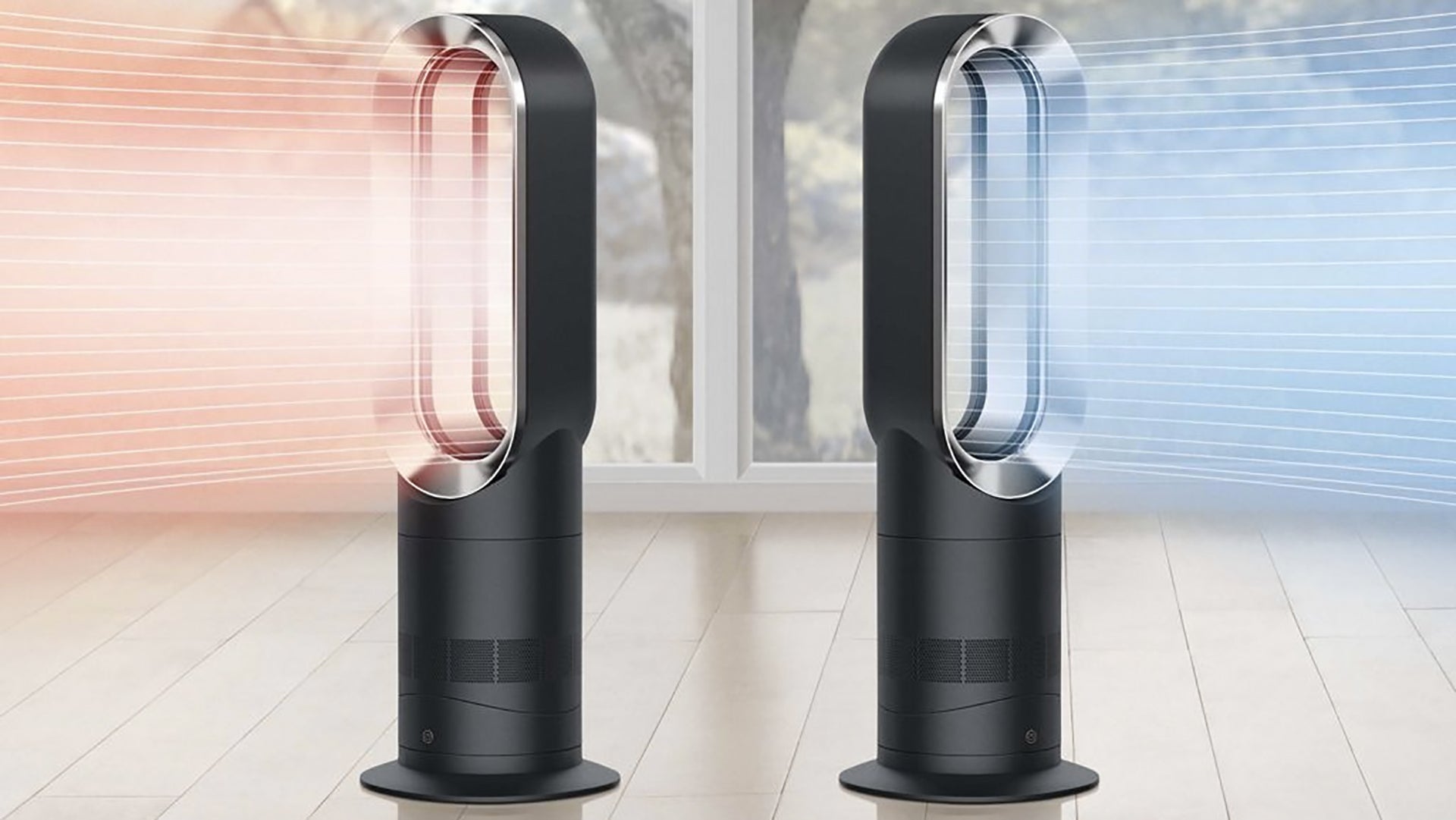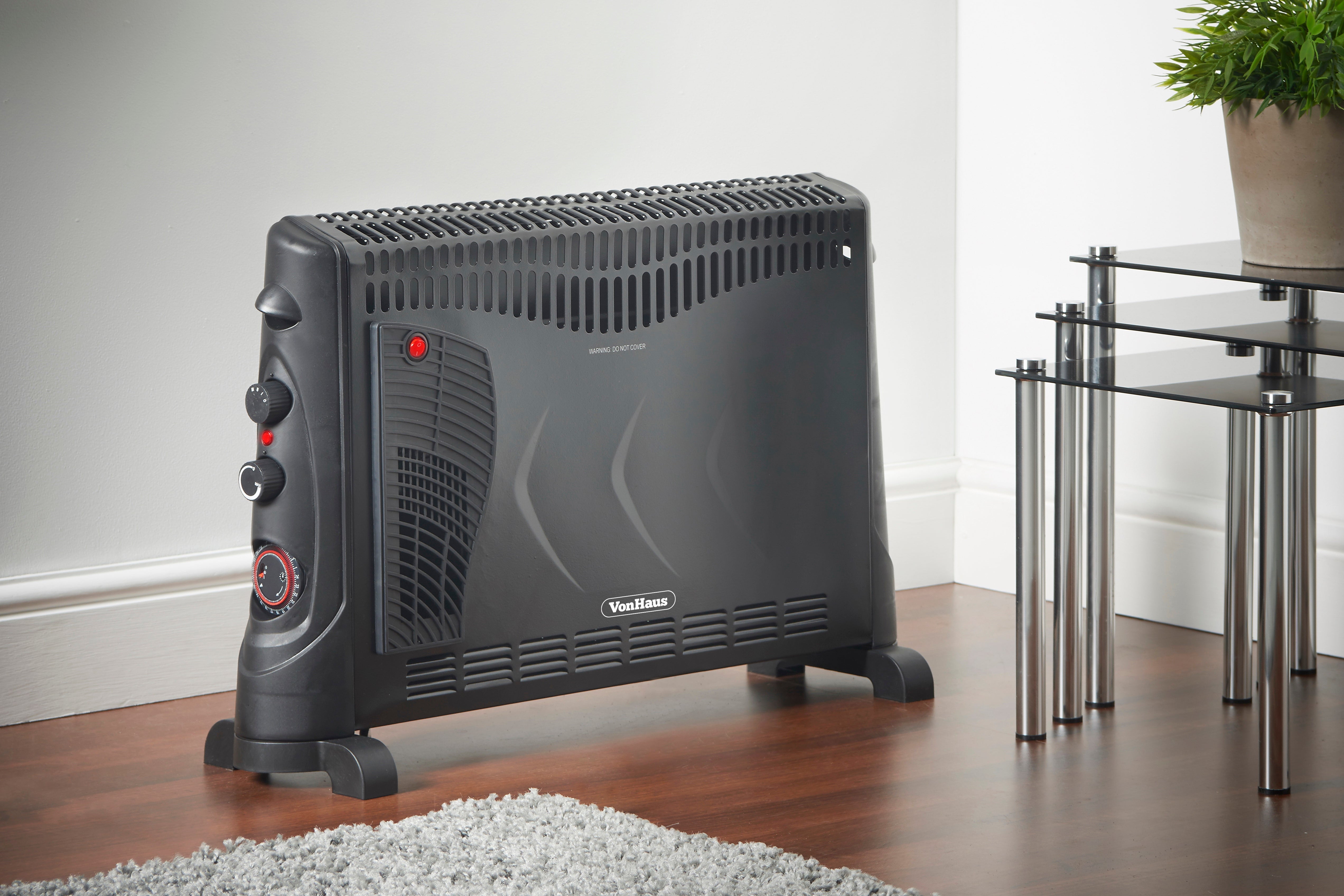The Princess Smart Infrared Heater is a worthy alternative to conventional electric fan heaters and radiators. It’s great for saving energy, but it doesn’t warm a room like conventional heaters. Given this, I’m not sure it has the right set of features and controls to make the most of its heating effect.
Pros
- Fast, direct heat
- Slimline design
- App control
Cons
- Inaccurate thermostat
- No movement sensor
Availability
- UKRRP: £124
- USAunavailable
- Europeunavailable
- Canadaunavailable
- Australiaunavailable
Introduction
Princess’ Smart Infrared Heater is a slimline, white panel heater with smart controls.
While conventional heaters rely on an element that mostly heats the air around them, this one uses an infrared element to radiate heat towards objects and people in the room. It’s more compact and efficient than a typical electric heater, but is it as effective?
Design and features
- A slimline, wall-mountable design
- App control
- Rated at just 350W
The Princess Smart Infrared Heater is available with three power ratings: 700W, 540W, and the 350W model I’m reviewing here. You might notice those ratings are considerably lower than typical for electric heaters, which usually come in at around 1-3kW. This model uses about a third of the electricity you’d burn running even a single element on a bar fire.
Infrared heaters have a markedly different effect to fan or convection heaters. The latter heat a room by circulating warm air which, over time, heats the room and everything in it. They also radiate heat, which is chiefly why it feels particularly warm when you stand directly in front of them. Infrared heaters, on the other hand, focus on this second method of heating. They directly warm up any people, surfaces or pets that their infrared light falls on. If you want to feel the benefit, you need to be reasonably close to the heater.
This heater’s very slim, with a depth of less than two centimetres. Other than that, it’s a similar size to a convector heater, and a fair bit bigger than the smallest fan heaters, such as the MeacoHeat Motion Eye 1.8kW Heater. From the front it looks like a featureless whiteboard, but there’s a small control box tucked away at the back that increases its overall depth to a little under 5cm. This includes a physical on/off switch, a backlit mono display, and five buttons.
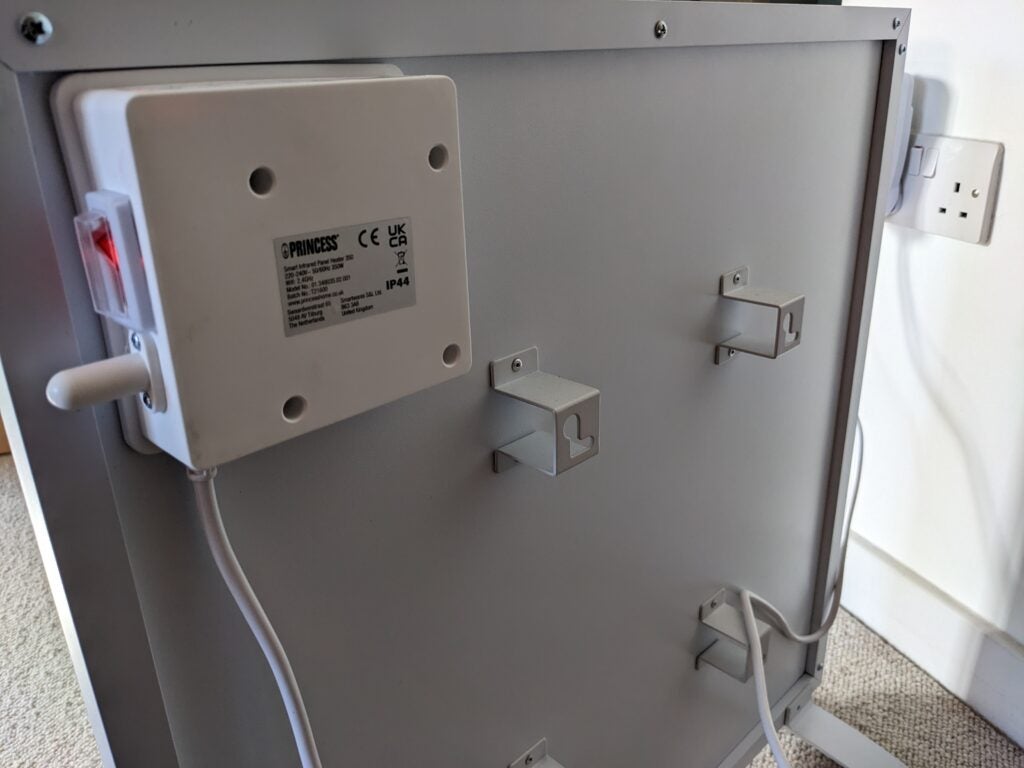
This heater comes with four integrated brackets for wall mounting, but if you’ll be using it free-standing you’ll need to fit the supplied metal feet.
This means removing and refitting two screws, but on my sample one of them was seized – I stripped the head trying to remove it, and ultimately had to make do with simply resting the heater in one of the feet. There’s no handle to help move it around, although this is a light heater and my sample never got too hot to touch during use.
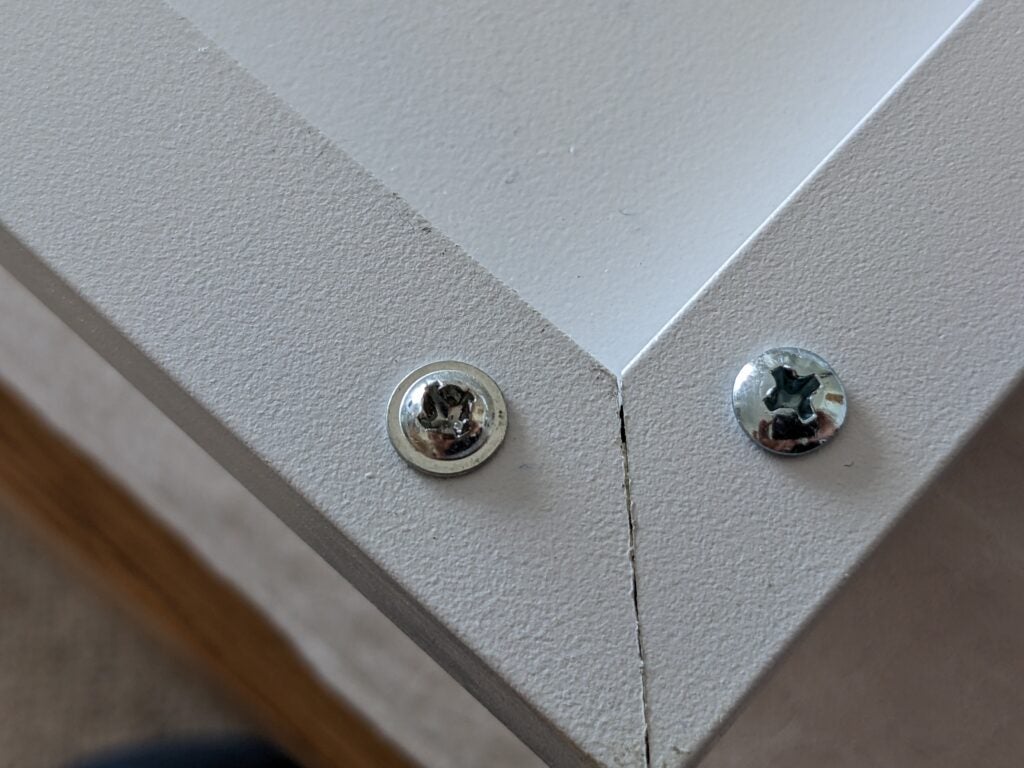
From the control panel you can turn the heater on or off, change the target temperature, and trigger the Wi-Fi pairing mode.
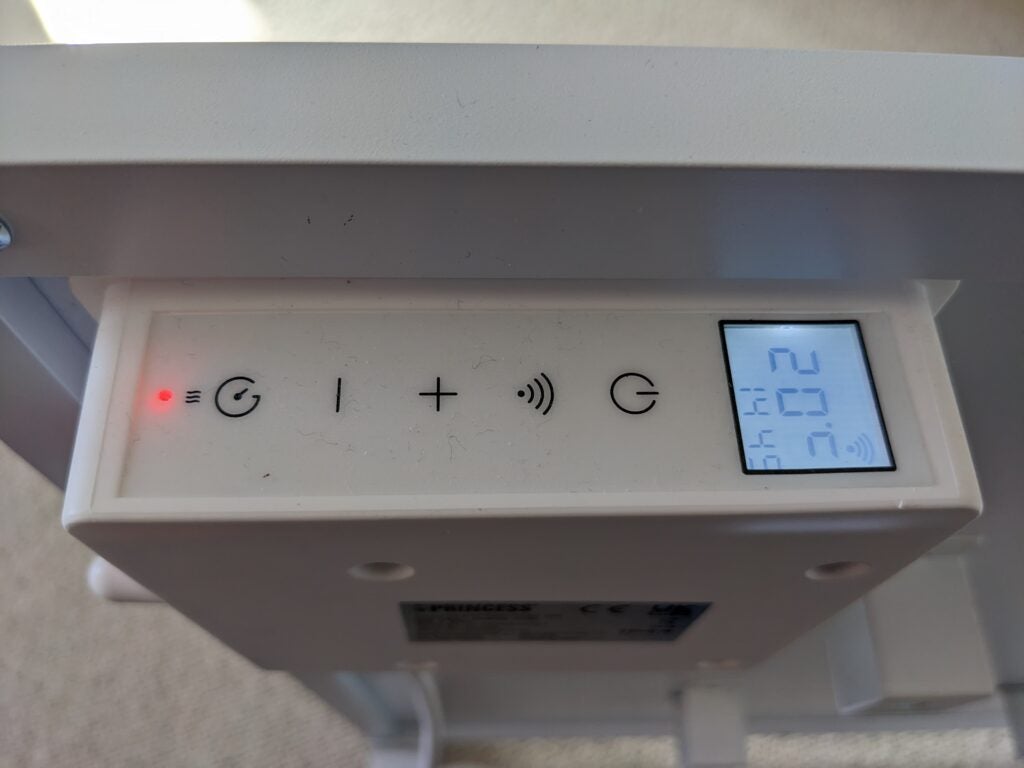
Princess’ app makes it easy to add and configure the heater, although on Android it nags you for Bluetooth and Location permissions every time you use it thereafter. I grumpily refused to grant them other than during setup, but the app still worked fine.
Princess’ app isn’t the most comprehensive I’ve used, but it does cover basics including setting a temperature, scheduling and setting an off timer. You can also create device groups, and integrate with Amazon Alexa or Google Assistant to allow voice control. Disappointingly there’s no child lock available, and this heater doesn’t have tip-over protection – to be fair it doesn’t seem to get hot enough to start a fire or cause scorching.
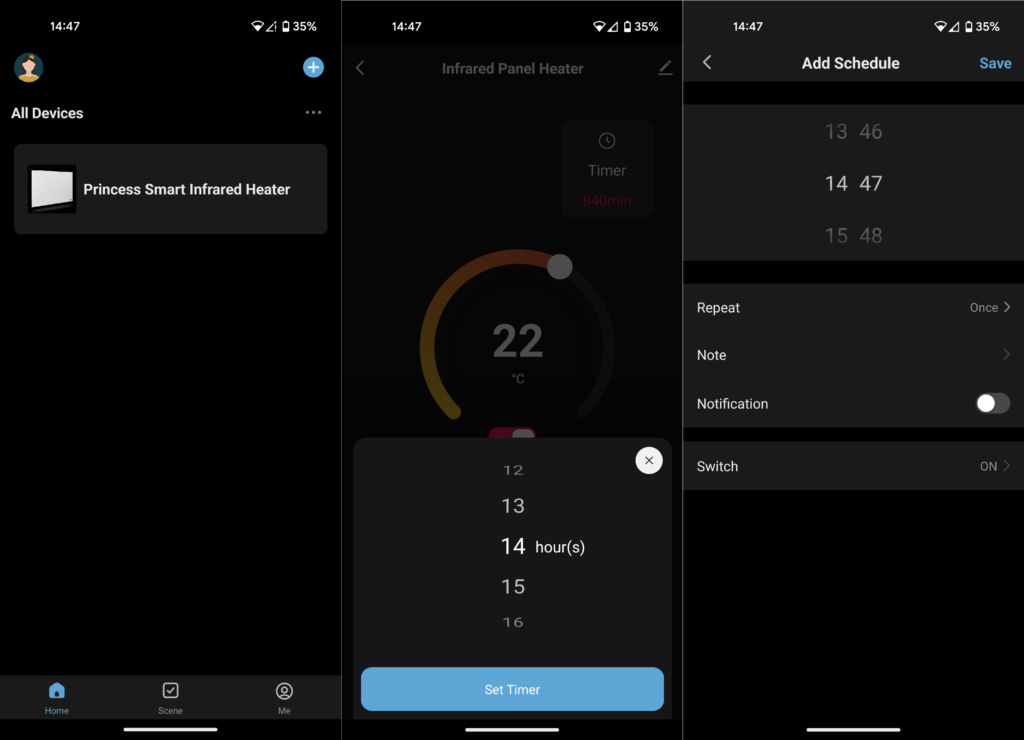
While some heaters benefit from smart controls, I’m not fully convinced here. Princess has covered all the basics, but remember that this device is about heating people directly, rather than the room. There’s less point in, for example, scheduling it to come on before bedtime if it’s not going to result in a toasty bedroom when you retire for the night. I wonder if the Smart Infrared Heater might benefit more from a movement sensor similar to the one used by Meaco’s Motion Eye 1.8kW. This would allow it to detect when you’re near, and switch on for a predefined time.
Performance
- Useful heating effect
- Silent operation
- Cheaper to run
This is a silent heater, apart from a beep whenever you change its target temperature. Unfortunately I couldn’t find a way to switch this off, but otherwise it should be easy to live with. That’s particularly true if you’re mounting it on a wall: it only stands about five centimetres proud, so it takes up little of your living space. Princess doesn’t mention or recommend it, but in theory it would be possible to mount this panel on a ceiling and have it still be effective. That’s the case for the Aeno Premium Eco Smart Heater; just make sure that ceiling mounting is done carefully.
Turn the Smart Infrared Heater on and you’ll quickly feel its warming effect, but it doesn’t have the blistering, powerful heat you’d get with a bar fire. That’s not necessarily a bad thing – it’s a less intense and drying heat, so it should be more comfortable for longer periods.
This heater is very sensitive to position, though. There’s little warming unless you’re directly in front of the panel, and the effect diminishes with distance. I found it very comfortable to sit around a metre away in an otherwise cool room, potentially making this a good heater for tucking away behind a desk. But while it doesn’t get as hot as conventional electric heaters, you’d still need to be careful where you put it to be sure you didn’t overheat nearby devices.
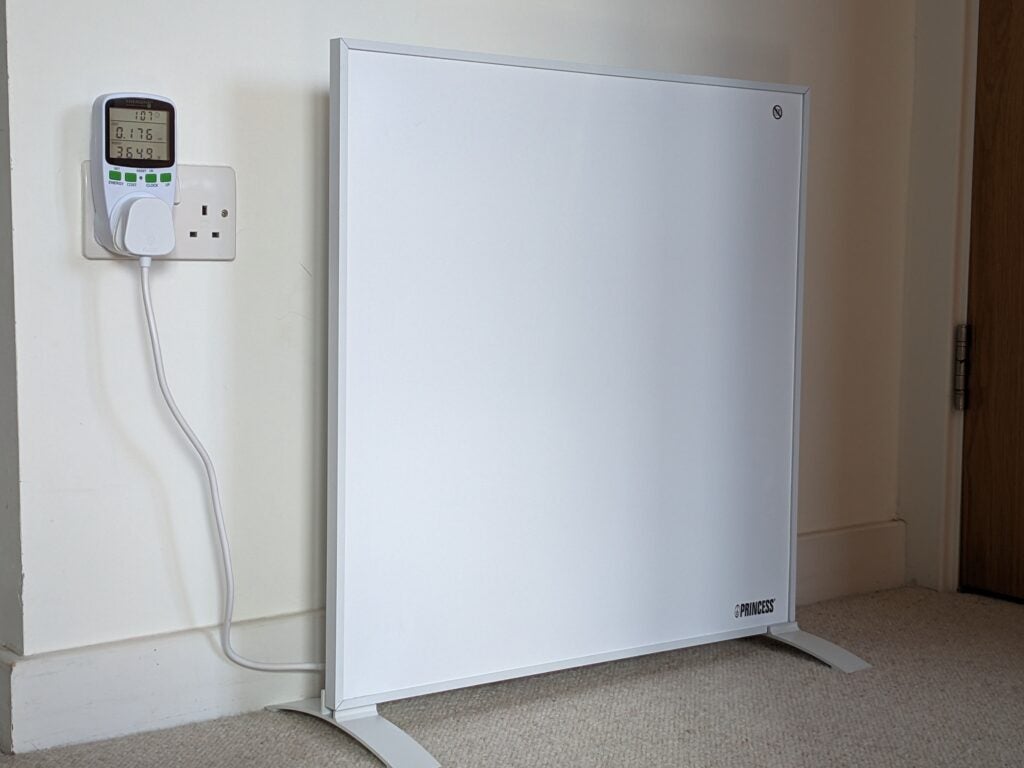
In use this heater is true to Princess’ power rating, consuming a peak of 365W, and falling below 1W when in standby. Over 30 minutes’ continuous use it consumed 0.19kWh – less than half what I’d expect from a typical fan or convection heater on its lowest setting, and about 6.3p at the current 34p per kilowatt hour price cap.
These low figures mean the Smart Panel Heater really should cost less to run than a typical electric heater, but to some extent this will be determined by how you use it. On constantly over an eight-hour working day, it would consume just under 3kWh of electricity, worth about £1 under the cap. But while a fan heater has much higher peak demands, it would quickly get a well-insulated room up to temperature, then cycle on and off to maintain it. Depending on your home and the weather, this means that a fan or convection heater could use less energy overall.
And here the Smart Infrared Heater is hamstrung somewhat by its unreliable thermostat. It’s accurate when it’s not actually heating, but it seems to be placed too close to the panel. Once heating, the temperature readings rapidly go up to unfeasible levels, and the heater cuts out far too quickly. I had to experiment to find the right target temperature, which was much higher than the true temperature I wanted. The temptation was just to set it to the maximum 37℃ and leave it there.
One final thought is that, although the Smart Infrared Heater does the bulk of its heating through infrared radiation, it does actually get warm and contribute a little heat through convection. It’s not much, but over 30 minutes it warmed my 48 square-metre bedroom from 16.6°C to 16.9°C, a small nudge upwards of 0.3°C.
Latest deals
Should you buy it?
You want a low-cost heater for a smaller room: This is an effective, low-energy heater for use in close quarters
You want faster heater for a larger space: Fan and convection heaters are more effective if you want to pre-heat a room
Final Thoughts
This is a slim, low-energy alternative to more typical convection or fan heaters, but it’s only suitable for close-up heating. It’s not a good way to, say, warm up your bedroom at the end of the evening. Infrared heaters should use a deal less power, but the Princess Smart Infrared Heater’s unreliable thermostat may encourage people to just leave it on, undoing those savings.
Overall it’s a decent product, and shows that infrared heating can be a sensible low-energy alternative, but it feels like Princess needs to add a little polish.
How we test
Unlike other sites, we test every heater we review thoroughly over an extended period of time. We use industry standard tests to compare features properly. We’ll always tell you what we find. We never, ever, accept money to review a product.
Find out more about how we test in our ethics policy.
FAQs
This heater is IP44 rated, so it’s resistant to splashes of water. That makes it suitable for bathroom use, but it’ll need to be wired in correctly – a standard plug socket isn’t suitable. You also shouldn’t cover it with a towel.
Princess doesn’t specifically state this, but most panels can be, provided they’re done professionally and securely.
The Princess Smart Infrared Heater is a worthy alternative to conventional electric fan heaters and radiators. It’s great for saving energy, but it doesn’t warm a room like conventional heaters. Given this, I’m not sure it has the right set of features and controls to make the most of its heating effect.
Pros
- Fast, direct heat
- Slimline design
- App control
Cons
- Inaccurate thermostat
- No movement sensor
Availability
- UKRRP: £124
- USAunavailable
- Europeunavailable
- Canadaunavailable
- Australiaunavailable
Introduction
Princess’ Smart Infrared Heater is a slimline, white panel heater with smart controls.
While conventional heaters rely on an element that mostly heats the air around them, this one uses an infrared element to radiate heat towards objects and people in the room. It’s more compact and efficient than a typical electric heater, but is it as effective?
Design and features
- A slimline, wall-mountable design
- App control
- Rated at just 350W
The Princess Smart Infrared Heater is available with three power ratings: 700W, 540W, and the 350W model I’m reviewing here. You might notice those ratings are considerably lower than typical for electric heaters, which usually come in at around 1-3kW. This model uses about a third of the electricity you’d burn running even a single element on a bar fire.
Infrared heaters have a markedly different effect to fan or convection heaters. The latter heat a room by circulating warm air which, over time, heats the room and everything in it. They also radiate heat, which is chiefly why it feels particularly warm when you stand directly in front of them. Infrared heaters, on the other hand, focus on this second method of heating. They directly warm up any people, surfaces or pets that their infrared light falls on. If you want to feel the benefit, you need to be reasonably close to the heater.
This heater’s very slim, with a depth of less than two centimetres. Other than that, it’s a similar size to a convector heater, and a fair bit bigger than the smallest fan heaters, such as the MeacoHeat Motion Eye 1.8kW Heater. From the front it looks like a featureless whiteboard, but there’s a small control box tucked away at the back that increases its overall depth to a little under 5cm. This includes a physical on/off switch, a backlit mono display, and five buttons.

This heater comes with four integrated brackets for wall mounting, but if you’ll be using it free-standing you’ll need to fit the supplied metal feet.
This means removing and refitting two screws, but on my sample one of them was seized – I stripped the head trying to remove it, and ultimately had to make do with simply resting the heater in one of the feet. There’s no handle to help move it around, although this is a light heater and my sample never got too hot to touch during use.

From the control panel you can turn the heater on or off, change the target temperature, and trigger the Wi-Fi pairing mode.

Princess’ app makes it easy to add and configure the heater, although on Android it nags you for Bluetooth and Location permissions every time you use it thereafter. I grumpily refused to grant them other than during setup, but the app still worked fine.
Princess’ app isn’t the most comprehensive I’ve used, but it does cover basics including setting a temperature, scheduling and setting an off timer. You can also create device groups, and integrate with Amazon Alexa or Google Assistant to allow voice control. Disappointingly there’s no child lock available, and this heater doesn’t have tip-over protection – to be fair it doesn’t seem to get hot enough to start a fire or cause scorching.

While some heaters benefit from smart controls, I’m not fully convinced here. Princess has covered all the basics, but remember that this device is about heating people directly, rather than the room. There’s less point in, for example, scheduling it to come on before bedtime if it’s not going to result in a toasty bedroom when you retire for the night. I wonder if the Smart Infrared Heater might benefit more from a movement sensor similar to the one used by Meaco’s Motion Eye 1.8kW. This would allow it to detect when you’re near, and switch on for a predefined time.
Performance
- Useful heating effect
- Silent operation
- Cheaper to run
This is a silent heater, apart from a beep whenever you change its target temperature. Unfortunately I couldn’t find a way to switch this off, but otherwise it should be easy to live with. That’s particularly true if you’re mounting it on a wall: it only stands about five centimetres proud, so it takes up little of your living space. Princess doesn’t mention or recommend it, but in theory it would be possible to mount this panel on a ceiling and have it still be effective. That’s the case for the Aeno Premium Eco Smart Heater; just make sure that ceiling mounting is done carefully.
Turn the Smart Infrared Heater on and you’ll quickly feel its warming effect, but it doesn’t have the blistering, powerful heat you’d get with a bar fire. That’s not necessarily a bad thing – it’s a less intense and drying heat, so it should be more comfortable for longer periods.
This heater is very sensitive to position, though. There’s little warming unless you’re directly in front of the panel, and the effect diminishes with distance. I found it very comfortable to sit around a metre away in an otherwise cool room, potentially making this a good heater for tucking away behind a desk. But while it doesn’t get as hot as conventional electric heaters, you’d still need to be careful where you put it to be sure you didn’t overheat nearby devices.

In use this heater is true to Princess’ power rating, consuming a peak of 365W, and falling below 1W when in standby. Over 30 minutes’ continuous use it consumed 0.19kWh – less than half what I’d expect from a typical fan or convection heater on its lowest setting, and about 6.3p at the current 34p per kilowatt hour price cap.
These low figures mean the Smart Panel Heater really should cost less to run than a typical electric heater, but to some extent this will be determined by how you use it. On constantly over an eight-hour working day, it would consume just under 3kWh of electricity, worth about £1 under the cap. But while a fan heater has much higher peak demands, it would quickly get a well-insulated room up to temperature, then cycle on and off to maintain it. Depending on your home and the weather, this means that a fan or convection heater could use less energy overall.
And here the Smart Infrared Heater is hamstrung somewhat by its unreliable thermostat. It’s accurate when it’s not actually heating, but it seems to be placed too close to the panel. Once heating, the temperature readings rapidly go up to unfeasible levels, and the heater cuts out far too quickly. I had to experiment to find the right target temperature, which was much higher than the true temperature I wanted. The temptation was just to set it to the maximum 37℃ and leave it there.
One final thought is that, although the Smart Infrared Heater does the bulk of its heating through infrared radiation, it does actually get warm and contribute a little heat through convection. It’s not much, but over 30 minutes it warmed my 48 square-metre bedroom from 16.6°C to 16.9°C, a small nudge upwards of 0.3°C.
Latest deals
Should you buy it?
You want a low-cost heater for a smaller room: This is an effective, low-energy heater for use in close quarters
You want faster heater for a larger space: Fan and convection heaters are more effective if you want to pre-heat a room
Final Thoughts
This is a slim, low-energy alternative to more typical convection or fan heaters, but it’s only suitable for close-up heating. It’s not a good way to, say, warm up your bedroom at the end of the evening. Infrared heaters should use a deal less power, but the Princess Smart Infrared Heater’s unreliable thermostat may encourage people to just leave it on, undoing those savings.
Overall it’s a decent product, and shows that infrared heating can be a sensible low-energy alternative, but it feels like Princess needs to add a little polish.
How we test
Unlike other sites, we test every heater we review thoroughly over an extended period of time. We use industry standard tests to compare features properly. We’ll always tell you what we find. We never, ever, accept money to review a product.
Find out more about how we test in our ethics policy.
FAQs
This heater is IP44 rated, so it’s resistant to splashes of water. That makes it suitable for bathroom use, but it’ll need to be wired in correctly – a standard plug socket isn’t suitable. You also shouldn’t cover it with a towel.
Princess doesn’t specifically state this, but most panels can be, provided they’re done professionally and securely.




















